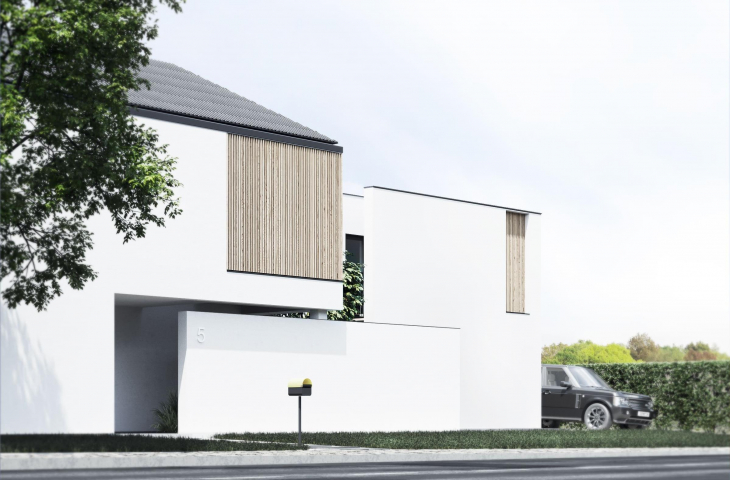A simple low-lying area on the outskirts of the city, devoid of landmarks or interesting views, surrounded by uninteresting eclectic buildings of the 1990s are aspects that architects from {tag:pracownie} faced. How to meet the expectations of the investor, a lover of vegetation and the associated views, when there is nothing to admire from the window? The Garden IN house is the answer to these questions.
Garden In closes to the uninteresting surroundings of the suburbs, in the interiors offering plenty of greenery
© kamecki.architecture
garden in the interior
It is common to see architecture that opens to the landscape, but what if there is nothing to open to, because we are surrounded by the blandness of the city? We decided to take as a starting point a garden, which we will "wake up" with living space. This is where an atrium house with an interior patio comes to mind. Such a solution usually ends up being quite extensive, and one of the most important points for the developer was to keep the development compact. Therefore, we decided to weave smaller green spaces into the body of the building. Our gardens are zones with a variety of vegetation, from one that needs minimal light to one that needs as much as possible," says architect Oskar Kamecki.
The masses are finished with white plaster and inserts of natural split granite, in places of window lintelsi
© kamecki.architecture
Zones with vegetation permeate the development, which consists of two buildings - a residential building and a garage, linking it functionally into one whole. In the garage building, on the second floor, there is a room equipped with sanitary facilities and a small kitchenette. This room can be used as a relaxation and party zone, a "guest house" or a place of work.
Garden In house, first floor plan
© kamecki.architektura
The space between the two buildings was left open by the architects, and its location provides shade during peak sunlight. The front elevation strongly insulates the house's occupants from the street, and places where daylight is needed, such as bedrooms, have been set back into the block, creating small terraces and balconies that have been obscured by wooden slats.
The dominant colors are muted shades of white and gray,
Which are the background for the play of light with green vegetation and the shadow it casts
© kamecki.architecture
interview with Oskar Kamecki
Dobrawa Bies: When designing the garden IN house you approached the task in an unusual way. The gray surroundings did not encourage scenic openings, so you closed the building, so to speak, directing it towards the inner garden. Where did you start your work?
Oskar Kamecki: We always start our work by defining the design framework, the points that guide us in the creative process. These are, of course, the standard constraints related to local conditions like the local plan or terrain, but also the spatial context and, of course, the needs of the investor. We always put a lot of emphasis on dialogue with the investor in order to get a good understanding of how he functions in everyday life and create a space in which he will feel comfortable. In the course of the first discussions we went through together, the slogan "lots of plants" was mentioned. We already knew that this would be the starting point.
The space between the buildings is open
© kamecki.architecture
Dobrawa: What requirements did the investors come with? Were you given design freedom?
Oskar Kamecki: The investors came to us with rather typical requirements - specifying their needs in terms of area, number of rooms. In doing so, they had a rather vision of a typical cataloger's house, of course, this is unfortunately due to the fact that the Internet "screams" to us with mass projects. From the very first meetings we were able to convince them that it is possible to approach the subject differently and they trusted us completely in this regard.
Dobrawa: In order to break the "grayness" of the surroundings in all spaces of the house you took care of a large number of plants - are they special species? Please tell us how you chose them.
Oskar Kamecki: Spaces that can be arranged with plants have a metered amount of light that reaches them. Their location was consulted in close cooperation with investors at the initial stages of the project. They are spread throughout the facility, smaller, larger, closed, open and semi-open, so that they provide vegetation for different species.
the architects wove smaller green spaces into the compact body of the building
© kamecki.architecture
Dobrawa: Garden IN house consists of two buildings - a residential building and a garage. What materials and solutions did you use in designing them?
Oskar Kamecki: We used traditional masonry technology supported by reinforced concrete studs and columns, on a reinforced concrete foundation slab. As for the finish, here we decided that we would rely on architecture that would be a background for the plants, i.e. white silicone plaster. In places, we broke the white spaces with detailing: inserts of natural slate granite, in the areas of the window lintels, and wooden slats in vertical orientation.
Dobrawa: The biggest challenge and the biggest reason to be proud is?
Oskar Kamecki: Proving to investors that a residential space doesn't have to close within the typical, replicated patterns of single-family development thinking. The function has to be fluid and tailored to the user. Result from his needs.
Dobrawa: Thank you for the interview.











































